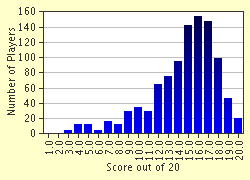Quiz Answer Key and Fun Facts
1. What was the pact, signed in 1949, that enabled the US to muster the conventional forces of much of Western Europe under US military leadership?
2. What was the Soviet Union and its satellite states' answer to West Germany's rearmament and admission into NATO?
3. When was the Berlin Wall constructed to prevent people leaving East Germany?
4. The Soviet Union and the USA never actually fought a 'hot' war against each other. Instead, the wars were fought by proxy against ideologies - in which of the following did the US govt NOT back a coup?
5. Who said in 1956: "There are only two ways: either peaceful co-existence or the most destructive war in history. There is no third way"?
6. Who was the first US President to visit Moscow?
7. What event saw the end of detente and led to a return to the Cold War climate between the USA and Soviet Union in 1979?
8. MAD was a principle that placed emphasis on the disastrous nature of employing nuclear weaponry. What does MAD stand for?
9. The concept behind MAD - a nuclear attack by one superpower would be met with a nuclear counterattack, such that both were annihilated.
10. The world teetered on the brink of a nuclear war in 1962 - what was the event that caused this?
11. President Nixon was elected on a platform of getting out of Vietnam. Did the USA leave Vietnam during his tenure as president?
12. What is 'Star Wars'?
13. Who announced the Star Wars programme in 1983?
14. Who officially canned the 'Star Wars' plans in 1993 (although they were resurrected by George W. Bush in 2001)?
15. Who introduced the policies of glasnost and perestroika, hoping to reform the Soviet system but instead unleashing forces that would lead to the eventual destruction of that system?
16. What did NATO's 'Partnership for Peace' program of 1994 encourage?
17. For the first time since WWII, the US and Russia co-operated at least diplomatically, against a common enemy in 1991. Who was it?
18. In March 1998 Yeltsin, known for his bizarre and erratic behaviour at times, sacked his entire Cabinet. What reason did he give for this decision?
19. Continued conflict in which of these areas during the 1990s caused some friction in US/Russian relations?
20. In 2001 Russia and the US co-operated in a war that is fought in a country that was once a Cold War battle ground. Which of these countries was it?
Source: Author
bridgey91
This quiz was reviewed by FunTrivia editor
bloomsby before going online.
Any errors found in FunTrivia content are routinely corrected through our feedback system.

